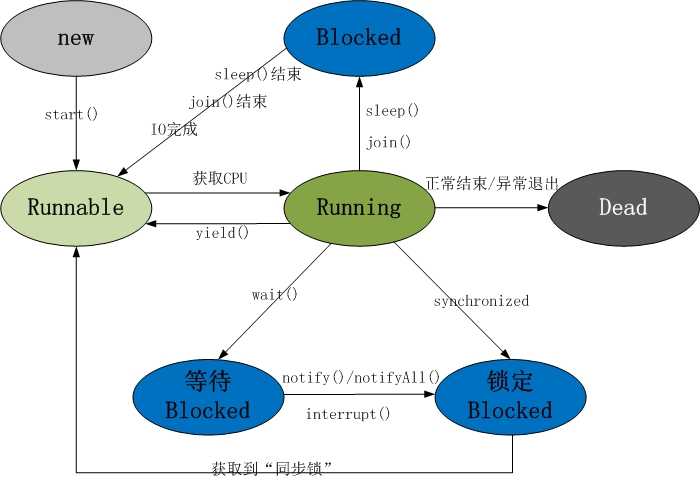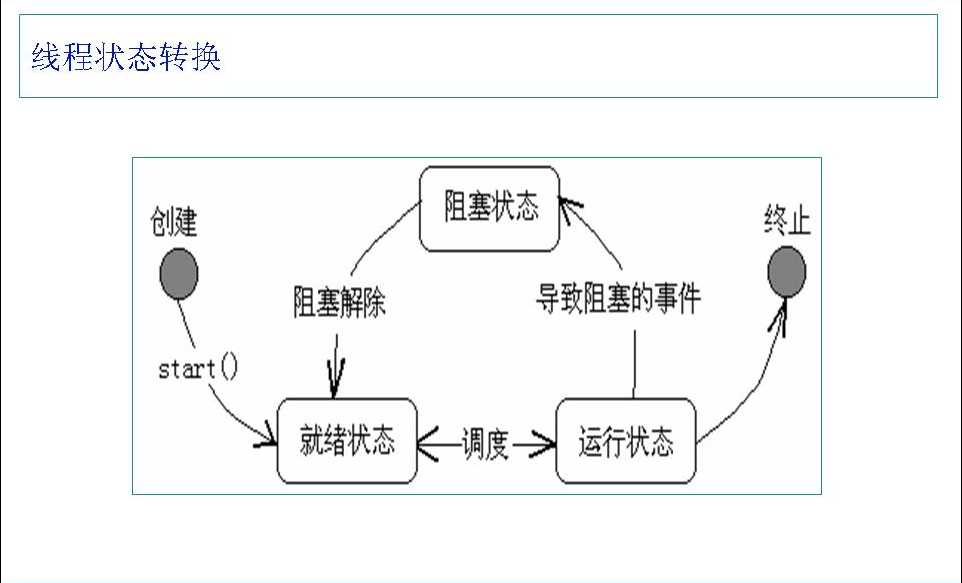标签:生命周期 swing tle 处理 死锁 bom height 应用 dead
1, 线程的概念
进程与线程
进程:每个进程都有独立的代码和数据空间(进程上下文),进程间的切换会有较大的开销,一个进程包含1--n个线程。(进程是资源分配的最小单位)
线程:同一类线程共享代码和数据空间,每个线程有独立的运行栈和程序计数器(PC),线程切换开销小。(线程是cpu调度的最小单位)
切换而不是同步
一个程序中的方法有几条执行路径, 就有几个线程
Java中线程的生命周期

Java线程具有五中基本状态
新建状态(New):当线程对象对创建后,即进入了新建状态,如:Thread t = new MyThread();
就绪状态(Runnable):当调用线程对象的start()方法(t.start();),线程即进入就绪状态。处于就绪状态的线程,只是说明此线程已经做好了准备,随时等待CPU调度执行,并不是说执行了t.start()此线程立即就会执行;
运行状态(Running):当CPU开始调度处于就绪状态的线程时,此时线程才得以真正执行,即进入到运行状态。注:就 绪状态是进入到运行状态的唯一入口,也就是说,线程要想进入运行状态执行,首先必须处于就绪状态中;
阻塞状态(Blocked):处于运行状态中的线程由于某种原因,暂时放弃对CPU的使用权,停止执行,此时进入阻塞状态,直到其进入到就绪状态,才 有机会再次被CPU调用以进入到运行状态。根据阻塞产生的原因不同,阻塞状态又可以分为三种:
1.等待阻塞:运行状态中的线程执行wait()方法,使本线程进入到等待阻塞状态;
2.同步阻塞 -- 线程在获取synchronized同步锁失败(因为锁被其它线程所占用),它会进入同步阻塞状态;
3.其他阻塞 -- 通过调用线程的sleep()或join()或发出了I/O请求时,线程会进入到阻塞状态。当sleep()状态超时、join()等待线程终止或者超时、或者I/O处理完毕时,线程重新转入就绪状态。
死亡状态(Dead):线程执行完了或者因异常退出了run()方法,该线程结束生命周期。
2, 线程的创建:
Thread类:
java.langClass Thread
- java.lang.Object
- java.lang.Thread
- All Implemented Interfaces:
- Runnable
- 已知直接子类:
- ForkJoinWorkerThread
线程是程序中执行的线程。 Java虚拟机允许应用程序同时执行多个执行线程。每个线程都有优先权。 具有较高优先级的线程优先于优先级较低的线程执行。 每个线程可能也可能不会被标记为守护程序。 当在某个线程中运行的代码创建一个新的
Thread对象时,新线程的优先级最初设置为等于创建线程的优先级,并且当且仅当创建线程是守护进程时才是守护线程。创建一个新的执行线程有两种方法。 一个是将一个类声明为
Thread的子类。 这个子类应该重写run类的方法Thread。另一种方法来创建一个线程是声明实现类
Runnable接口。 那个类然后实现了run方法。 然后可以分配类的实例,在创建Thread时作为参数传递,并启动。
两种方式:
1, 继承Thread类
class TestThread extends Thread {......}
1 package com.hanqi.maya.test;
2
3 import javax.swing.plaf.FontUIResource;
4 import javax.swing.text.StyledEditorKit.ForegroundAction;
5
6 public class Threadtest {
7 public static void main(String[] args) {
8 MyThread mt=new MyThread();
9 mt.start();//开启线程
10 for(int i=0;i<50;i++){
11 System.out.println("main"+i);
12 }
13 }
14 }
15 class MyThread extends Thread{ //通过继承Thread类的方法来创建多线程
16
17 public void run(){
18 for(int i=0;i<50;i++){
19 System.out.println("MyThead"+i);
20 }
21 }
22
23 }
2, 实现Runnable接口, 然后作为参数传入到Thread类的构造方法中
class TestThread implements Runnable {......}
1 package com.hanqi.maya.test;
2
3 import javax.swing.plaf.FontUIResource;
4 import javax.swing.text.StyledEditorKit.ForegroundAction;
5
6 public class Threadtest {
7 public static void main(String[] args) {
8 MyThread mt=new MyThread();
9
10 Thread t=new Thread(mt);
11 t.start();//自动去找t中实现的Runnable方法
12 for(int i=0;i<50;i++){
13 System.out.println("main"+i);
14 }
15 /*
16 mt.start();//开启线程
17 for(int i=0;i<50;i++){
18 System.out.println("main"+i);
19 }*/
20 }
21 }
22
23 class MyThread implements Runnable{ //通过继承Thread类的方法来创建多线程
24
25 public void run(){
26 for(int i=0;i<50;i++){
27 System.out.println("MyThead"+i);
28 }
29 }
30
31 }
32 /*class MyThread extends Thread{ //通过继承Thread类的方法来创建多线程
33
34 public void run(){
35 for(int i=0;i<50;i++){
36 System.out.println("MyThead"+i);
37 }
38 }
39
40 }*/
线程的启动:
调用线程类中的start()方法, 不能直接调用run()方法, 直接调用run()方法是方法调用, 不是启动线程
3, 线程常用方法

isAlive()
判断线程是否还活着, 调用start()之前和终止之后都是死的, 其他的都是活的
判断线程是否还在
1 package com.hanqi.maya.test;
2
3 public class TestThread1 {
4 public static void main(String[] args) {
5 MyThread1 mt=new MyThread1();
6
7 Thread t=new Thread(mt);
8
9 System.out.println(t.isAlive());//判断线程是否还在,此处线程未开启
10 t.start();
11 System.out.println(t.isAlive());//判断线程是否还在,此处线程已经开启
12 }
13 }
14
15 class MyThread1 implements Runnable{ //通过继承Thread类的方法来创建多线程
16
17 public void run(){
18 for(int i=0;i<50;i++){
19 System.out.println("MyThead"+i);
20 }
21 }
22 }
优先级
getPriority()
setPriority()
设置优先级, 优先级的概念: 谁的优先级高, 谁执行的时间就多
Thread里面的默认优先级:
Thread.MIN_PRIORITY = 1
Thread.MAX_PRIORITY = 10
Thread.NORM_PRIORITY = 5
1 package com.hanqi.maya.test;
2
3 public class TestPriority {
4 public static void main(String[] args) {
5 MyThread11 mt1 = new MyThread11("超人");
6 MyThread2 mt2 = new MyThread2("蝙蝠侠");
7 mt1.setPriority(Thread.NORM_PRIORITY + 5);//设置优先级
8 mt1.start();
9 mt2.start();
10 System.out.println("123");
11 try {
12 Thread.sleep(2000);
13 } catch (InterruptedException e) {
14 // TODO Auto-generated catch block
15 e.printStackTrace();
16 }
17 System.out.println(456);
18 }
19 }
20
21
22 class MyThread11 extends Thread {
23
24 public MyThread11(String name) {
25 super(name);//调用父类构造方法将name穿减去
26 }
27
28 public void run() {
29 for (int i = 0; i < 50; i++) {
30 System.out.println(this.getName() + ": " + i);
31 }
32 }
33 }
34
35 class MyThread2 extends Thread {
36
37 public MyThread2(String name) {
38 super(name);
39 }
40
41 public void run() {
42 for (int i = 0; i < 50; i++) {
43 System.out.println(this.getName() + ": " + i);
44 }
45 }
46 }
沉睡和终止
interrupt()
停止线程
这个方法要配合延迟使用,不要直接启动线程然后直接使用此方法
1 package interupt;
2
3 import java.util.Date;
4
5 public class TestInterupt {
6 public static void main(String[] args) {
7 MyNewThread mnt = new MyNewThread();
8 Thread t = new Thread(mnt);
9 t.start();
10 try {
11 Thread.sleep(5000);
12 } catch (InterruptedException e) {
13 e.printStackTrace();
14 }
15 t.interrupt();
16 t.stop();
17 // 终止线程, 将run方法结束, 线程就结束了
18 MyNewThread.flag = false;
19 }
20 }
21
22 class MyNewThread implements Runnable {
23
24 static boolean flag = true;
25 @Override
26 public void run() {
27 while(flag) {
28 System.out.println(new Date());
29 try {
30 Thread.sleep(1000);
31 } catch (Exception e) {
32 System.out.println("线程终止 !");
33 System.out.println(e.getMessage());
34 return;
35 }
36 }
37 }
38
39 }
Thread.sleep(long millions)将程序暂停一会,暂停当前线程,如果没有线程也可以给普通程序暂停,需要抛出一个异常即可
1 package com.hanqi.maya.test;
2
3 import java.util.Date;
4
5 public class TestInterupt {
6 public static void main(String[] args) {
7 MyNewThread mnt = new MyNewThread();
8 Thread t = new Thread(mnt);
9 t.start();
10 try {
11 Thread.sleep(5000);//先沉睡5s
12 } catch (InterruptedException e) {
13 e.printStackTrace();
14 }
15 /*t.interrupt();//调用会抛出异常
16 t.stop();//不建议使用,已经过时
17 */// 终止线程, 将run方法结束, 线程就结束了
18 MyNewThread.flag = false;//更改属性终止线程
19 }
20 }
21
22 class MyNewThread implements Runnable {
23
24 static boolean flag = true;
25 @Override
26 public void run() {
27 while(flag) {
28 System.out.println(new Date());
29 try {
30 Thread.sleep(1000);//延迟一秒
31 } catch (Exception e) {
32 System.out.println("线程终止 !");
33 System.out.println(e.getMessage());
34 return;
35 }
36 }
37 }
38
39 }
join()
合并线程
1 package join;
2
3 public class TestJoin {
4 public static void main(String[] args) {
5 NewThread nt = new NewThread();
6 nt.start();
7 try {
8 nt.join();//合并线程,继承自Thread,将这个线程加到当前线程,先执行这个线程
9 } catch (InterruptedException e) {
10 e.printStackTrace();
11 }
12
13 for (int i = 0; i < 10; i++) {
14 System.out.println("我是main线程-----" + i);
15 }
16 }
17 }
18
19 class NewThread extends Thread {
20 public void run() {
21 for (int i = 0; i < 10; i++) {
22 System.out.println("我是NewThread线程=====" + i);
23 }
24 }
25 }
yield()---礼让
让出CPU执行其他线程
1 package com.hanqi.maya.test;
2
3 public class TestPriority {
4 public static void main(String[] args) {
5 MyThread11 mt1 = new MyThread11("超人");
6 MyThread2 mt2 = new MyThread2("蝙蝠侠");
7 mt1.setPriority(Thread.NORM_PRIORITY + 5);//设置优先级
8 mt1.start();
9 mt2.start();
10 System.out.println("123");
11 try {
12 Thread.sleep(2000);
13 } catch (InterruptedException e) {
14 // TODO Auto-generated catch block
15 e.printStackTrace();
16 }
17 System.out.println(456);
18 }
19 }
20
21
22 class MyThread11 extends Thread {
23
24 public MyThread11(String name) {
25 super(name);//调用父类构造方法将name穿减去
26 }
27
28 public void run() {
29 for (int i = 0; i < 50; i++) {
30 System.out.println(this.getName() + ": " + i);
31 }
32 }
33 }
34
35 class MyThread2 extends Thread {
36
37 public MyThread2(String name) {
38 super(name);
39 }
40
41 public void run() {
42 for (int i = 0; i < 50; i++) {
43 System.out.println(this.getName() + ": " + i);
44 }
45 }
46 }
wait()
notify()方法或notifyAll()方法,或指定的时间已过。notify()
public final void notify()
wait方法之一等待对象的监视器。
唤醒的线程将无法继续,直到当前线程放弃此对象上的锁定为止。 唤醒的线程将以通常的方式与任何其他线程竞争,这些线程可能正在积极地竞争在该对象上进行同步; 例如,唤醒的线程在下一个锁定该对象的线程中没有可靠的权限或缺点。
notifyAll()---
public final void notifyAll()
wait方法之一等待对象的监视器。
唤醒的线程将无法继续,直到当前线程释放该对象上的锁。 唤醒的线程将以通常的方式与任何其他线程竞争,这些线程可能正在积极地竞争在该对象上进行同步; 例如,唤醒的线程在下一个锁定该对象的线程中不会有可靠的特权或缺点。
4, 线程同步
synchronized
线程的同步是保证多线程安全访问竞争资源的一种手段。
当多个线程同时读写同一份共享资源的时候,可能会引起冲突。这时候,我们需要引入线程“同步”机制,即各位线程之间要有个先来后到的执行。
线程同步的真实意思和字面意思恰好相反。线程同步的真实意思,其实是“排队”:几个线程之间要排队,一个一个对共享资源进行操作,而不是同时进行操作。
比如银行取钱:
银行卡余额3000,A从取款机取2000,B也想从支付宝这张卡转出2000,这时就要用到线程同步
线程同步,可以在方法声明中用 synchronized 关键字
也可以用 synchronized 关键字将代码块包起来实现
1 package com.hanqi.util;
2
3 public class Bank {
4 public int money=3000;
5
6 public /*synchronized*/ void getMoney(String name,int mon){
7 synchronized(this){
8 if(money>mon&&money>0){
9 try {
10 Thread.sleep(1);
11 } catch (InterruptedException e) {
12 e.printStackTrace();
13 }
14
15 money-=mon;
16 System.out.println("hi,"+name);
17 System.out.println("取款"+mon);
18 System.out.println("余额:"+money);
19
20 }else{
21 System.out.println("hi,"+name);
22 System.out.println("取款失败");
23 System.out.println("余额:"+money);
24 }
25 }
26 }
27 }
1 package com.hanqi.util;
2
3 public class Threadt1 {
4
5 public static void main(String[] args) {
6 MyThread mt=new MyThread();
7
8 Thread t1=new Thread(mt);
9 Thread t2=new Thread(mt);
10
11 t1.setName("Tom");
12 t2.setName("BomSa");
13
14 t1.start();
15 t2.start();
16 }
17 }
18 class MyThread implements Runnable{
19 public Bank bank=new Bank();
20 @Override
21 public void run() {
22 bank.getMoney(Thread.currentThread().getName(), 2000);
23 }
24 }
五、死锁概念
所谓死锁,是两个甚至多个线程被永久阻塞时的一种运行局面,这种局面的生成伴随着至少两个线程和两个或者多个资源。两个或两个以上的进程在执行过程中,因争夺资源而造成的一种互相等待的现象,若无外力作用,它们都将无法推进下去。此时称系统处于死锁状态或系统产生了死锁,这些永远在互相等待的进程称为死锁进程。由于资源占用是互斥的,当某个进程提出申请资源后,使得有关进程在无外力协助下,永远分配不到必需的资源而无法继续运行,这就产生了一种特殊现象死锁。
1 package com.hanqi.util;
2
3 public class Deadlock implements Runnable {
4
5
6 public static void main(String[] args) {
7
8 Deadlock d1 = new Deadlock();
9 Deadlock d2 = new Deadlock();
10
11 d1.flag = 1;
12 d2.flag = 2;
13
14 Thread t1 = new Thread(d1);
15 Thread t2 = new Thread(d2);
16
17 t1.start();
18 t2.start();
19
20 }
21
22 public static Object obj1 = new Object();
23 public static Object obj2 = new Object();
24
25 public int flag;
26
27 @Override
28 public void run() {
29 if (flag == 1) {
30 System.out.println("这是第" + flag + "个线程");
31 synchronized (obj1) {
32 try {
33 Thread.sleep(500);
34 } catch (InterruptedException e) {
35 e.printStackTrace();
36 }
37 synchronized (obj2) {
38 System.out.println("第" + flag + "个线程结束");
39 }
40 }
41 }
42
43 if (flag == 2) {
44 System.out.println("这是第" + flag + "个线程");
45 synchronized (obj2) {
46 try {
47 Thread.sleep(500);
48 } catch (InterruptedException e) {
49 e.printStackTrace();
50 }
51 synchronized (obj1) {
52 System.out.println("第" + flag + "个线程结束");
53 }
54 }
55 }
56
57 }
58
59 }
标签:生命周期 swing tle 处理 死锁 bom height 应用 dead
原文地址:http://www.cnblogs.com/jiangwz/p/7273179.html